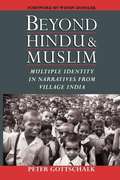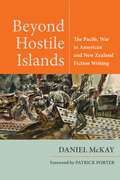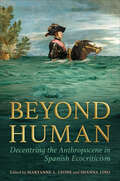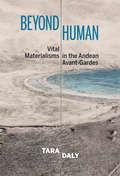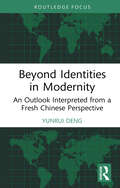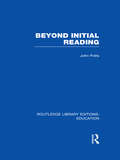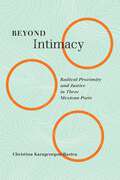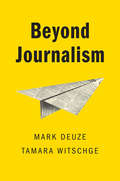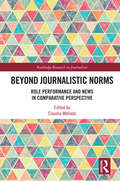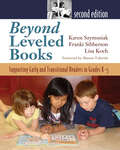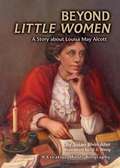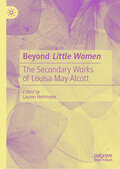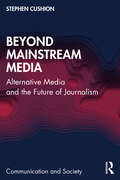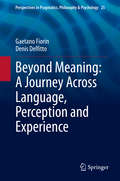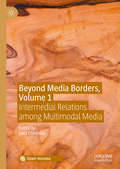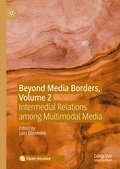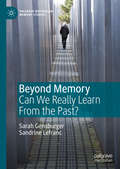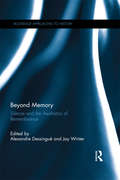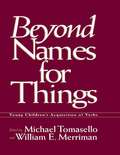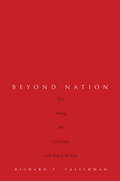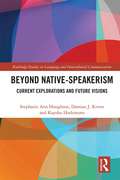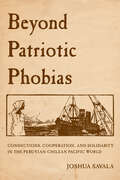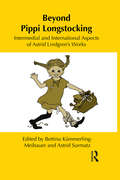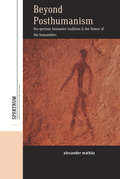- Table View
- List View
Beyond Greek: The Beginnings of Latin Literature
by Denis FeeneyAncient Roman authors are firmly established in the Western canon, and yet the birth of Latin literature was far from inevitable. The cultural flourishing that eventually produced the Latin classics was one of the strangest events in history, as Denis Feeney demonstrates in this bold revision.
Beyond Hindu and Muslim: Multiple Identity In Narratives From Village India
by Wendy Doniger Peter Gottschalk"The book offers a deep and meticulous ethnography of persons talking about who they are--in relation to a particular place or set of places, situated both in time and space. This book achieves a rare balance between accessibility and richness." --Journal of the American Oriental Society "In South Asia's current climate, in which forces of religious revivalism have taken violent turns, it is more than ever necessary to understand how Indians' multiple identities actually work. Gottschalk's carefully researched monograph provides an excellent starting point; it deserves a wide readership."
Beyond Hostile Islands: The Pacific War in American and New Zealand Fiction Writing (World War II: The Global, Human, and Ethical Dimension)
by Daniel McKayWINNER, JAVIER COY BIENNIAL RESEARCH AWARD, BEST MONOGRAPHOffers a fascinating window into how the fraught politics of apology in the East Asian region have been figured in anglophone literary fiction.The Pacific War, 1941-1945, was fought across the world’s largest ocean and left a lasting imprint on anglophone literary history. However, studies of that imprint or of individual authors have focused on American literature without drawing connections to parallel traditions elsewhere. Beyond Hostile Islands contributes to ongoing efforts by Australasian scholars to place their national cultures in conversation with those of the United States, particularly regarding studies of the ideologies that legitimize warfare. Consecutively, the book examines five of the most significant historical and thematic areas associated with the war: island combat, economic competition, internment, imprisonment, and the atomic bombing of Hiroshima and Nagasaki.Throughout, the central issue pivots around the question of how or whether at all New Zealand fiction writing differs from that of the United States. Can a sense of islandness, the ‘tyranny of distance,’ Māori cultural heritage, or the political legacies of the nuclear-free movement provide grounds for distinctive authorial insights? As an opening gambit, Beyond Hostile Islands puts forward the term ‘ideological coproduction’ to describe how a territorially and demographically more minor national culture may accede to the essentials of a given ideology while differing in aspects that reflect historical and provincial dimensions that are important to it. Appropriately, the literary texts under examination are set in various locales, including Japan, the Solomon Islands, New Zealand, New Mexico, Ontario, and the Marshall Islands. The book concludes in a deliberately open-ended pose, with the full expectation that literary writing on the Pacific War will grow in range and richness, aided by the growth of Pacific Studies as a research area.
Beyond Human: Decentring the Anthropocene in Spanish Ecocriticism (Toronto Iberic #83)
by Maryanne L. Leone Shanna LinoChronicling sixteenth-century Spain to the present day, Beyond Human aims to decentre the human and acknowledge the material historicity of more-than-human nature. The book explores key questions relating to ecological equity, justice, and responsibility within and beyond Spain in the Anthropocene. Examining relations between Iberian cultural practices, historical developments, and ecological processes, Maryanne L. Leone, Shanna Lino, and the contributors to this volume reveal the structures that uphold and dismantle the non-human–human dichotomy and nature-culture divide. The book critiques works from the Golden Age to the twenty-first century in a wide range of genres, including comedia, royal treatises, agricultural reports, paintings, satirical essays, horror fiction and film, young adult and speculative literature, poetry, graphic novels, and television series. The authors contend that Spanish cultural studies must expose the material historicity that entangles today’s ecological crises and ecosocial injustices with previous, future, and contemporary entities. The book argues that this will require the simultaneous decentring of the human and of the Anthropocene as an ecocritical framework. By standardizing ecosocial analysis and widening avenues for ecopedagogical approaches, Beyond Human participates in the ecocentric transformation of Hispanic cultural studies.
Beyond Human: Vital Materialisms in the Andean Avant-Gardes (Bucknell Studies in Latin American Literature and Theory)
by Tara DalyIn the Andes, indigenous knowledge systems based on the relationships between different beings, both earthly and heavenly, animal and plant, have been central to the organization of knowledge since precolonial times. The legacies of colonialism and the continuance of indigenous cultures makes the Andes a unique place from which to think about art and social change as ongoing, and as encompassing more than an exclusively human perspective. Beyond Human revises established readings of the avant-gardes in Peru and Bolivia as humanizing and historical. By presenting fresh readings of canonical authors like César Vallejo, José María Arguedas, and Magda Portal and through analysis of newer artist-activists like Julieta Paredes, Mujeres Creando Comunidad, and Alejandra Dorado, Daly argues instead that avant-gardes complicate questions of agency and contribute to theoretical discussions on vital materialisms: the idea that life happens between animate and inanimate beings—human and non-human—and is made sensible through art. Published by Bucknell University Press. Distributed worldwide by Rutgers University Press.
Beyond Identities in Modernity: An Outlook Interpreted from a Fresh Chinese Perspective
by Yunrui DengThis book argues that future generations of modernity as a whole will shape participatory modernization whether Chinese modernization or Western modernization. The public discourse is inundated with the good and the bad modern events with the acceleration of globalization.This book debates that the biggest question in the twenty-first century is not who will dominate, touting a new world order upon us, but rather that it is the orientation of modernization that haunts our daily realities. This book explores the idea that life is not about living for an identity in any society, it is about the demands for dignity and safety. It goes further to state that there is also a demand for the power of being, and these three elements are beyond identities as modernization moves forward. Interdisciplinary in nature, the book uses theories, data, and philosophy as toolboxes to align with microrealities around the globe. Witnessing modernization and modernizing identities in China and in Australia beyond day by day, the author provides a more suitable, more realistic, and possibly, more nuanced perspective.This book will be of interest to professionals, students, academics, as well as businesspeople with China experience, interested in modernization and identity, the Chinese perspective, and the new generation of Chinese.
Beyond Initial Reading (Routledge Library Editions: Education)
by John PottsThis book sets out a clear and logical framework for the teaching of reading throughout different age groups, whereby systematic progression can be developed within a structured framework. A detailed set of recommendations are offered and are both illustrated and justified, for the teacher to examine and use. Much has been written about the importance of skilled and efficient reading and language usage in the early years of education, but all too few teachers are aware of the need for the development of reading skills in an ordered sequence with older children as well. Problems such as the motivation of the learner, the place of reading in a mass media age, the extent and classification of reading failure and the diagnosis of reading problems are examined, and the complexities of the linguistic background and of linguistic deprivation are covered thoroughly.
Beyond Intimacy: Radical Proximity and Justice in Three Mexican Poets (McGill-Queen's Iberian and Latin American Cultures Series)
by Christina Karageorgou-BasteaThe ethos of poetry and its social efficacy cannot be underestimated in the quest for a fair society. The works of three contemporary Mexican poets – Abigael Bohórquez, Myriam Moscona, and Gloria Gervitz – offer models for examining important philosophical and literary questions that explore the relationship between art and the enactment of justice. Beyond Intimacy returns lyric poetry to the centre of struggles for justice within concrete historical frameworks, highlighting gender, ethnic, and cultural tensions. Through an analysis of works by these three poets, Christina Karageorgou-Bastea reveals the far-reaching social transcendence of poetry; she shows that lyric poetry invites a public dialogue where queer pariahs model citizenship, a dying language guards and transmits tradition, and the end of motherhood is the cusp in the struggle for woman’s freedom. The radicalization of intimacy, the relationship par excellence between self and other on which poetic interaction is based, has the power to dismantle deeply rooted hierarchies within art and society. Karageorgou-Bastea explores poetry’s potential for justice through different modes of intimacy including desire, filiation, and mourning.Meeting on the grounds of their aspiration to harmony, lyricism, and justice-making lead the way to social equity and fairness in Beyond Intimacy.
Beyond Journalism
by Mark Deuze Tamara WitschgeIn the context of profound transformations in the professional, business, technological and social context of journalism, it is crucial for journalism studies and education to move beyond limited approaches to the discipline. Among the most significant changes affecting journalism worldwide is the emergence of startup culture, as more and more journalists strike out on their own. In Beyond Journalism, Deuze and Witschge combine extensive global and comparative fieldwork. Through rich case studies of journalism startups around the world, they provide deep insight into the promises and pitfalls of media entrepreneurship. Ultimately, they aim to recognize new and emerging voices as legitimate participants in the discourse about what journalism is, can be and should be. A bold manifesto as well as an in-depth empirical study, this book is essential reading for students and scholars of journalism, media, communication, and related disciplines.
Beyond Journalistic Norms: Role Performance and News in Comparative Perspective (Routledge Research in Journalism)
by Claudia MelladoBeyond Journalistic Norms contests and challenges pre-established assumptions about a dominant type of journalism prevailing in different political, economic, and geographical contexts to posit the fluid, and dynamic nature of journalistic roles. The book brings together scholars from Western and Eastern Europe, North America, Latin America, and Asia, reporting findings based on data collected from democratic, transitional, and non-democratic contexts to produce thematic chapters that address how journalistic cultures vary around the globe, specifically in relation to challenges that journalists face in performing their journalistic roles. The study measures, compares, and analyzes the materialization of the interventionist, the watchdog, the loyal-facilitator, the service, the infotainment, and the civic roles in more than 30,000 print news stories from 18 countries. It also draws from hundreds of surveys with journalists to explain the link between ideals and practices, and the conditions that shape this divide. This book will be of great relevance to scholars and researchers working in the fields of journalism, journalism practices, philosophy of journalism, sociology of media, and comparative journalism research.
Beyond Leveled Books: Supporting Early and Transitional Readers in Grades K-5
by Lisa Koch Franki Sibberson Karen SzymusiakIn Beyond Leveled Books, Second Edition, Franki Sibberson, Karen Szymusiak, and Lisa Koch provide even more resources to help teachers understand and meet the needs of transitional readers. The key topic of series books has been revised and enlarged, with charts outlining new series with the challenges they pose and supports readers need. New lessons have been added, and most chapters now include a related article from a literacy expert. Some of the contributors include Kathy Collins, Larry Swartz, and Mary Lee Hahn.Leveled books are an indispensable tool for teaching children to read, especially for emergent readers, but the authors of Beyond Leveled Books are sounding the alarm about the overuse and misuse of leveling and the way it restricts teacher autonomy and undermines student choice and reading engagement. The authors lay out a blueprint for using leveled books effectively within a student-centered and differentiated approach that is designed to motivate all readers, particularly transitional ones. Teaching Transitional Readers: Beyond Leveled Books is packed with resources to help teachers understand and meet the needs of transitional readers, including examples of classroom instruction, sample mini-lessons, strategies for small-group instruction, assessment techniques, and articles by literacy expertsResources for K-5 Classrooms: The book explores the uses and limitations of leveled texts in primary reading instruction, including ideas for how to organize your classroom library and a list of great books and series to use alongside leveled text in supporting new readersGateway to Independent Reading: The authors provide explicit tools for helping students consolidate their skills and reading strategies, to read widely and deeply, to increase their vocabulary, and build critical thinkingMaking Reading Fun: Teach students to experience joy from reading through deeper comprehension and applicationBeyond Leveled Books is an essential resource for K-5 teachers looking to help all readers, including budding readers, struggling readers, transitional readers, and readers who have plateaued.
Beyond Little Women: A Story about Louisa May Alcott
by Susan Bivin AllerA biographical account of the life of Louisa May Alcott.
Beyond Little Women: The Secondary Works of Louisa May Alcott
by Lauren HehmeyerThis collection concentrates on the secondary works of Louisa May Alcott and looks at the idea that Alcott was as heavily influenced by her times as by her transcendentalist upbringing. Her work often subverts the conventional and includes the new, the practical, and the real. The sections include: (1) the gothic and the monstrous feminine, (2) the theme of useful work, (3) the themes of physical and mental health, and (4) Alcott’s philosophy concerning creativity and genius. Contributors emphasize Alcott’s belief in women’s agency and argue that Alcott can be considered as a brilliant bridge between the Transcendental idealism of the early nineteenth century and later reforms.
Beyond Mainstream Media: Alternative Media and the Future of Journalism (Communication and Society)
by Stephen CushionOffering one of the most comprehensive assessments of alternative media to date, Beyond Mainstream Media examines the rise of alternative media over the last decade, analysing their changing content and editorial strategies, and exploring why many people go beyond the mainstream media for news and information. Considering the differences in agenda between alternative and mainstream media coverage, Cushion sheds light on why right-wing alternative media have become a more prominent part of national media systems than left-wing sites in the Western World. In doing so, he argues that alternative left-wing media should place less emphasis on attacking professional journalism and focus more on converging into the world of mainstream news to promote their politics. This book draws on over 3,500 articles and 17,000 social media posts produced by alternative media, extensive interviews with editors and contributors, and a survey of over 2,700 media users. It develops a comparative international perspective by explaining how findings and concepts can be applied to understanding much broader issues, such as public distrust in the mainstream media or the influence different media and political systems have on the production of alternative media. Providing both an introduction to and a critical analysis of the state of alternative media today, this book is written in clear, jargon-free language and is recommended reading for advanced students undertaking courses in Alternative Media and Political Journalism.
Beyond Meaning: A Journey Across Language, Perception and Experience (Perspectives in Pragmatics, Philosophy & Psychology #25)
by Gaetano Fiorin Denis DelfittoNatural languages – idioms such as English and Cantonese, Zulu and Amharic, Basque and Nicaraguan Sign Language – allow their speakers to convey meaning and transmit meaning to one another. But what is meaning exactly? What is this thing that words convey and speakers communicate? Few questions are as elusive as this. Yet, few features are as essential to who we are and what we do as human beings as the capacity to convey meaning through language. In this book, Gaetano Fiorin and Denis Delfitto disclose a notion of linguistic meaning that is structured around three distinct, yet interconnected dimensions: a linguistic dimension, relating meaning to the linguistic forms that convey it; a material dimension, relating meaning to the material and social conditions of its environment; and a psychological dimension, relating meaning to the cognitive lives of its users. By paying special attention to the puzzle surrounding first-person reference – the way speakers exploit language to refer to themselves – and by capitalizing on a number of recent findings in the cognitive sciences, Fiorin and Delfitto develop the original hypothesis that meaningful language shares the same underlying logical and metaphysical structure of sense perception, effectively acting as a system of classification and discrimination at the interface between cognitive agents and their ecologies.
Beyond Media Borders, Volume 1: Intermedial Relations among Multimodal Media
by Lars ElleströmThis open access book promotes the idea that all media types are multimodal and that comparing media types, through an intermedial lens, necessarily involves analysing these multimodal traits. The collection includes a series of interconnected articles that illustrate and clarify how the concepts developed in Elleström’s influential article The Modalities of Media: A Model for Understanding Intermedial Relations (Palgrave Macmillan, 2010) can be used for methodical investigation and interpretation of media traits and media interrelations. The authors work with a wide range of old and new media types that are traditionally investigated through limited, media-specific concepts. The publication is a significant contribution to interdisciplinary research, advancing the frontiers of conceptual as well as practical understanding of media interrelations. This is the first of two volumes. It contains Elleström’s revised article and six other contributions focusing especially on media integration: how media products and media types are combined and merged in various ways.
Beyond Media Borders, Volume 2: Intermedial Relations among Multimodal Media
by Lars ElleströmThis open access book promotes the idea that all media types are multimodal and that comparing media types, through an intermedial lens, necessarily involves analysing these multimodal traits. The collection includes a series of interconnected articles that illustrate and clarify how the concepts developed in Elleström’s influential article The Modalities of Media: A Model for Understanding Intermedial Relations (Palgrave Macmillan, 2010) can be used for methodical investigation and interpretation of media traits and media interrelations. The authors work with a wide range of old and new media types that are traditionally investigated through limited, media-specific concepts. The publication is a significant contribution to interdisciplinary research, advancing the frontiers of conceptual as well as practical understanding of media interrelations. This is the second of two volumes. It contains a concluding article by Elleström and seven contributions concentrated on the issue of media transformations: how media characteristics are transferred and transfigured among various media products and media types.
Beyond Memory: Can We Really Learn From the Past? (Palgrave Macmillan Memory Studies)
by Sarah Gensburger Sandrine LefrancThis book provides a fresh perspective on the familiar belief that memory policies are successful in building peaceful societies. Whether in a stable democracy or in the wake of a violent political conflict, this book argues that memory policies are unhelpful in preventing hate, genocide, and mass crimes. Since the 1990s, transmitting the memory of violent pasts has been utilised in attempts to foster tolerance and fight racism, hate and antisemitism. However, countries that invested in memory policies have overseen the rise of hate crimes and populisms instead of growing social cohesion. Breaking with the usual moralistic position, this book takes stock of this situation. Where do these memory policies come from? Whom do they serve? Can we make them more effective? In other words, can we really learn from the past? At a time when memory studies is blooming, this book questions the normative belief in the effects of memory.
Beyond Memory: Silence and the Aesthetics of Remembrance (Routledge Approaches to History)
by Alexandre Dessingué Jay M. WinterBeyond Memory: Silence and the Aesthetics of Remembrance analyses the intricate connections between silence, acts of remembrance and acts of forgetting, and relates the topic of silence to the international research field of Cultural Memory Studies. It engages with the most recent work in the field by viewing silence as a remedy to the traditionally binary approach to our understanding of remembering and forgetting. The international team of contributors examine case studies from colonialism, war, politics and slavery from across the globe, as well as drawing examples from literature, philosophy and sites of memory to draw three main conclusions. Firstly, that the relationship between remembering and forgetting is relational rather than ‘hermetic’, and the space between the two is often occupied by silence. Secondly, silence is a force in itself, capable of stimulating more or less remembrance. Finally, that silence is a necessary and key element in the interaction between the human mind and the ‘outer world’, and enables people to challenge their understanding of art, music, literature, history and memory. With an introduction by the editors discussing Memory Studies, and concluding remarks by Astrid Erll, this collection demonstrates that acceptance and consideration of silence as having both a performative and aesthetic dimension is an essential component of history and memory studies.
Beyond Names for Things: Young Children's Acquisition of Verbs
by Michael Tomasello William E. MerrimanMost research on children's lexical development has focused on their acquisition of names for concrete objects. This is the first edited volume to focus specifically on how children acquire their early verbs. Verbs are an especially important part of the early lexicon because of the role they play in children's emerging grammatical competence. The contributors to this book investigate: * children's earliest words for actions and events and the cognitive structures that might underlie them, * the possibility that the basic principles of word learning which apply in the case of nouns might also apply in the case of verbs, and the role of linguistic context, especially argument structure, in the acquisition of verbs. A central theme in many of the chapters is the comparison of the processes of noun and verb learning. Several contributors make provocative suggestions for constructing theories of lexical development that encompass the full range of lexical items that children learn and use.
Beyond Nation
by Richard CalichmanIn the work of writer Abe Kobo (1924-1993), characters are alienated both from themselves and from one another. Through close readings of Abe's work, Richard Calichman reveals how time and writing have the ability to unground identity. Over time, attempts to create unity of self cause alienation, despite government attempts to convince people to form communities (and nations) to recapture a sense of wholeness. Art, then, must resist the nation-state and expose its false ideologies. Calichman argues that Abe's attack on the concept of national affiliation has been neglected through his inscription as a writer of Japanese literature. At the same time, the institution of Japan Studies works to tighten the bond between nation-state and individual subject. Through Abe's essays and short stories, he shows how the formation of community is constantly displaced by the notions of time and writing. Beyond Nation thus analyzes the elements of Orientalism, culturalism, and racism that often underlie the appeal to collective Japanese identity.
Beyond Native-Speakerism: Current Explorations and Future Visions (Routledge Studies in Language and Intercultural Communication)
by Stephanie Ann Houghton Damian J. Rivers Kayoko HashimotoDespite unsubstantiated claims of best practice, the division of language-teaching professionals on the basis of their categorization as ‘native-speakers’ or ‘non-native speakers’ continues to cascade throughout the academic literature. It has become normative, under the rhetorical guise of acting to correct prejudice and/or discrimination, to see native-speakerism as having a single beneficiary – the ‘native-speaker’ – and a single victim – the ‘non-native’ speaker. However, this unidirectional perspective fails to deal with the more veiled systems through which those labeled as native-speakers and non-native speakers are both cast as casualties of this questionable bifurcation. This volume documents such complexities and aims to fill the void currently observable within mainstream academic literature in the teaching of both English, and Japanese, foreign language education. By identifying how the construct of Japanese native-speaker mirrors that of the ‘native-speaker’ of English, the volume presents a revealing insight into language teaching in Japan. Further, taking a problem-solving approach, this volume explores possible grounds on which language teachers could be employed if native-speakerism is rejected according to experts in the fields of intercultural communicative competence, English as a Lingua Franca and World Englishes, all of which aim to replace the ‘native-speaker’ model with something new.
Beyond Patriotic Phobias: Connections, Cooperation, and Solidarity in the Peruvian-Chilean Pacific World
by Joshua SavalaThe War of the Pacific (1879–1883) looms large in the history of Peru and Chile. Upending the prevailing historiographical focus on the history of conflict, Beyond Patriotic Phobias explores points of connection shared between Peruvians and Chileans despite war. Through careful archival work, historian Joshua Savala highlights the overlooked cooperative relationships of workers across borders, including maritime port workers, doctors, and the police. These groups, in both countries, were intimately tied together through different forms of labor: they worked the ships and ports, studied and treated disease transmission in the face of a cholera outbreak, and conducted surveillance over port and maritime activities because of perceived threats like transnational crime and labor organizing. By following the movement of people, diseases, and ideas, Savala reconstructs the circulation that created a South American Pacific world. The resulting story is one in which communities, classes, and states formed transnationally through varied, if uneven, forms of cooperation.
Beyond Pippi Longstocking: Intermedial and International Approaches to Astrid Lindgren's Work (Children's Literature and Culture)
by Bettina Kümmerling-Meibauer Astrid SurmatzAstrid Lindgren, author of the famed Pippi Longstocking novels, is perhaps one of the most significant children's authors of the last half of the twentieth century. In this collection contributors consider films, music, and picturebooks relating to Lindgren, in addition to the author's reception internationally. Touching on everything from the Astrid Lindgren theme park at Vimmerby, Sweden to the hidden folk songs in Lindgren's works to the use of nostalgia in film adaptations of Lindgren's novels, this collection offers an important international and intermedial portrait of Lindgren research today.
Beyond Posthumanism: The German Humanist Tradition and the Future of the Humanities (Spektrum: Publications of the German Studies Association #22)
by Alexander MathäsKant, Goethe, Schiller and other eighteenth-century German intellectuals loom large in the history of the humanities—both in terms of their individual achievements and their collective embodiment of the values that inform modern humanistic inquiry. Taking full account of the manifold challenges that the humanities face today, this volume recasts the question of their viability by tracing their long-disputed premises in German literature and philosophy. Through insightful analyses of key texts, Alexander Mathäs mounts a broad defense of the humanistic tradition, emphasizing its pursuit of a universal ethics and ability to render human experiences comprehensible through literary imagination.

